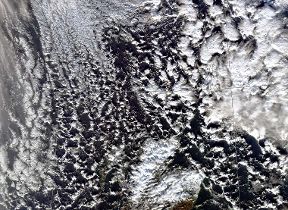What is convection?
Convection is the movement within a liquid or gas driven by differences in temperature.
How does convection work?
Convection works by areas of a liquid or gas heating or cooling greater than their surroundings, causing differences in temperature. These temperature differences then cause the areas to move as the hotter, less dense areas rise, and the cooler, more dense areas sink.
Often the areas of heating and cooling are fixed, and allow convective cycles or currents to become established. For example, a saucepan of water over a flame may develop convective currents as the water is heated from below, rises to the surface, and cools. Once cooled enough, the water then sinks back to the bottom of the saucepan where the cycle is repeated, and the convective overturning continues.
Why does convection occur?
Convection is a vital process which helps to redistribute energy away from hotter areas to cooler areas of the Earth, aiding temperature circulation and reducing sharp temperature differences. Without convection simple tasks such as boiling water in a kettle would be much slower as only the water directly in contact with the heat ring at the bottom of the kettle would be able to be heated, with the water at the top staying cool.
How is convection different from conduction?
Convection is the movement of particles through a substance, transporting their heat energy from hotter areas to cooler areas. Conduction however, doesn’t necessarily involve particles moving. Instead energy is passed from one particle to another upon contact, transferring heat. As a result, conduction in liquids and gases is a much slower process than convection, as particles are free to move and direct contact is reduced. However, conduction is much more effective in solids than convection, as the particles are densely packed, continuously touching one another to allow an efficient transfer of heat. Additionally, in solids particles fixed and unable to move, stopping the transfer of energy via convection.
How does convection affect the weather?
Convection within the atmosphere can often be observed in our weather. For example, as the sun heats the Earth’s surface, the air above it heats up and rises. If conditions allow, this air can continue to rise, cooling as it does so, forming Cumulus clouds. Stronger convection can result in much larger clouds developing as the air rises higher before it is cooled, sometimes producing Cumulonimbus clouds and even thunderstorms.
Can convection be seen?
Convection is the rising motion of warmer areas of a liquid or gas, and the sinking motion of cooler areas of liquid or gas, sometimes forming a complete cycle. However, it is often difficult to see, particularly within the air. Nevertheless, if convective clouds form during a sunny day, they can often be observed growing in size and getting taller as more and more air rises from the surface and condenses higher up into the cloud.
How does convection affect ocean currents?
Ocean currents act as conveyor-like circulations which help distribute heat away from the equator and nearer the poles. However, these currents are affected by convection due to the influence of ocean temperature and salinity (concentration of salt within the water) on density.
Warm ocean waters near the equator are pushed polewards with prevailing wind patterns, and are carried into the higher latitudes where they are cooled through evaporation and the interaction with the colder winds. Consequently, salinity increases and temperature decreases, causing the waters to become denser and therefore sink through the convection process. This sinking process is known as downwelling, and is vital in driving ocean currents by feeding water into the deep water currents which transports it back to the tropics. Therefore, without convection, waters would not be able to rise / sink, stopping to transfer of water between the poles and the equator.





